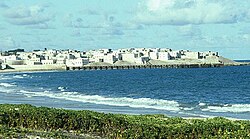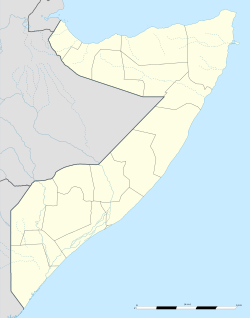Barawa
Barawa Baraawe مدينة ﺑَﺮَﺍﻭَة Madīna Barāwa | |
|---|---|
City | |
 Barawa seafront | |
| Nickname(s): Brava Ierè | |
 Barawa Location in Somalia. | |
| Coordinates: 1°06′48″N 44°01′49″E / 1.11333°N 44.03028°E / 1.11333; 44.03028Coordinates: 1°06′48″N 44°01′49″E / 1.11333°N 44.03028°E / 1.11333; 44.03028 | |
| Country | |
| Region | Lower Shebelle |
| District | Barawa |
| Elevation | 0 m (0 ft) |
| Population [citation needed] | |
| • Total | 42,800 |
| Time zone | UTC+3 (EAT) |
| Area code(s) | +35261[citation needed] |
Barawa (Somali: Baraawe, Arabic: مدينة ﺑﺮﺍﻭة Madīna Barāwa), also known as Barawe and Brava, is a port town in the southwestern Lower Shebelle region of Somalia. It is mainly inhabited a multiracial ethnic group known as the Bravanese people and the Tunni clan.
Contents
1 History
1.1 Medieval
1.2 Contemporary
2 Politics
3 Demographics
4 Gallery
5 References
6 Bibliography
7 External links
History
Medieval
During the Middle Ages, Barawa and its surrounding area was part of the Ajuran Empire that governed much of southern Somalia and eastern Ethiopia, with its domain extending from Hobyo in the north, to Qelafo in the west, to Kismayo in the south.[1]
From his experiences during the Ming treasure voyages in the early 15th century, the Chinese mariner Fei Xin characterized the people of Barawa as pure and honest.[2]
In 1506, the Battle of Barawa began after the Portuguese Empire decided to invade and capture the wealthy Somali harbour city. The powerful commander who led the Portuguese army was Tristão da Cunha who he set his eyes on the Ajuran territory, where the battle of Barawa was fought. After a long period of engagement, the Portuguese soldiers burned the city and looted it. However, fierce resistance by the local population and soldiers resulted in the failure of the Portuguese to permanently occupy the city and eventually the Portuguese would be decisively defeated by the powerful Somalis from Ajuran Empire, and the inhabitants who had fled to the interior would eventually return and rebuild the city. Tristão da Cunha was later severely wounded and sought refuge in Socotra islands after losing his men and ships. After the battle, the city of Barawa quickly recovered from the attack.[3]
In the early modern period, Barawa was ruled by the Geledi Sultanate. Eventually, in 1910, Barawa was ceded to the control of the Italians when the Geledi Sultanate was forced to agree to the annexation of all the Banadir ports to the Italian Company already established in the Horn of Africa after the death of the last Sultan Osman Ahmed in 1910. But still, the Italians faced stiff resistance from many parts of the Banadir coast, and its inland regions and the trade of the Somali merchants would remain unchallenged for years to come.[4]
Sheikh Uways al-Barawi organised an Ikhwaan and led the Banadir revolt, which was duly crushed in 1908.[5]
Contemporary
In addition to the famous Sheikh Uways, Baraawe has produced numerous well respected Ulama including Sheikh Uways al-Barawi, Sheikh Nureini Sabiri, Sheikh Hajii Sadiq, Sheikh Qassim al-Baraawi, Sheikh Ma'llim Nuri, Sharif Qulatayn and a female poet-saint, Dada Masiti.[6] The city was the stronghold of the Hizbiya Digil-Mirifle (HDM) party, which was founded in 1947 and later became the Hizb al-Dastuur Mustaqil al-Somali (Somali Independent Constitutional Party, HDMS).[7]
Politics
In 2009, Al-Shabaab militants seized control of Barawa.[8] In September of the year, a United States military raid in the area killed Saleh Ali Saleh Nabhan, a suspected Al-Qaeda operative.[8] In October 2013, United States Navy SEAL Team Six also launched an unsuccessful raid against a beachside house in Barawa, targeting Mukhtar Abu Zubeyr, the leader of Al-Shabaab.[9] Following the unsuccessful raid, al-Shabab began a crack down of the town.[10]
Following the launch of Operation Indian Ocean, the Somali Armed Forces assisted by AMISOM troops re-seized control of Barawa from Al-Shabaab in October 2014.[11] On October 11, during a trip to Barawe President Hassan banned charcoal trade in the city.[12]
Demographics
Barawa has a population of around 32,800 inhabitants.[13] The broader Barawa District has a total population of 96,0901 residents.[14]
The city is home to a multiracial confederation of clans known as Bravanese people as well as the Tunni clan.
In addition to Standard Somali, the Tunni speak Af-Tunni (a dialect of Somali) and the Bravanese speak Chimwiini (a dialect of Swahili).[15]
Gallery
 Charcoal in the port |  Exporting Charcoal by Indian boat |  small volvos carriying Charcoal to the ship |  Pakistani in barava on their coal trade boat  volvo boat loading coal to the big boat, |
|---|---|---|---|
 Barawa beach |  Small fish boats |  Charcoal in the port waiting export |
References
^ Lee V. Cassanelli, The shaping of Somali society: reconstructing the history of a pastoral people, 1600-1900, (University of Pennsylvania Press: 1982), p.102.
^ Dreyer, Edward L. (2007). Zheng He: China and the Oceans in the Early Ming Dynasty, 1405–1433. New York: Pearson Longman. p. 88. ISBN 9780321084439..mw-parser-output cite.citation{font-style:inherit}.mw-parser-output .citation q{quotes:"""""""'""'"}.mw-parser-output .citation .cs1-lock-free a{background:url("//upload.wikimedia.org/wikipedia/commons/thumb/6/65/Lock-green.svg/9px-Lock-green.svg.png")no-repeat;background-position:right .1em center}.mw-parser-output .citation .cs1-lock-limited a,.mw-parser-output .citation .cs1-lock-registration a{background:url("//upload.wikimedia.org/wikipedia/commons/thumb/d/d6/Lock-gray-alt-2.svg/9px-Lock-gray-alt-2.svg.png")no-repeat;background-position:right .1em center}.mw-parser-output .citation .cs1-lock-subscription a{background:url("//upload.wikimedia.org/wikipedia/commons/thumb/a/aa/Lock-red-alt-2.svg/9px-Lock-red-alt-2.svg.png")no-repeat;background-position:right .1em center}.mw-parser-output .cs1-subscription,.mw-parser-output .cs1-registration{color:#555}.mw-parser-output .cs1-subscription span,.mw-parser-output .cs1-registration span{border-bottom:1px dotted;cursor:help}.mw-parser-output .cs1-ws-icon a{background:url("//upload.wikimedia.org/wikipedia/commons/thumb/4/4c/Wikisource-logo.svg/12px-Wikisource-logo.svg.png")no-repeat;background-position:right .1em center}.mw-parser-output code.cs1-code{color:inherit;background:inherit;border:inherit;padding:inherit}.mw-parser-output .cs1-hidden-error{display:none;font-size:100%}.mw-parser-output .cs1-visible-error{font-size:100%}.mw-parser-output .cs1-maint{display:none;color:#33aa33;margin-left:0.3em}.mw-parser-output .cs1-subscription,.mw-parser-output .cs1-registration,.mw-parser-output .cs1-format{font-size:95%}.mw-parser-output .cs1-kern-left,.mw-parser-output .cs1-kern-wl-left{padding-left:0.2em}.mw-parser-output .cs1-kern-right,.mw-parser-output .cs1-kern-wl-right{padding-right:0.2em}
^ The book of Duarte Barbosa - Page 30
^ The End of Slavery in Africa By Suzanne Miers, Richard L. Roberts
^ The Sheikh subsequently migrated to Biyoley to reorganize his Ikhwan, but was killed in 1909. One result of the unsuccessful revolt was the establishment of the Uwaysiyya order, named after the martyr Sheikh Uways, which succeeded in establishing jama’as in the riverine region of southern Somalia and neighboring regions, which acted as centres of charity and learning.
^ Ahmed, Ali Jimale, ed. (1995). The Invention of Somalia (1st ed.). Lawrenceville, N.J.: Red Sea Press. p. 34. ISBN 978-0-932415-99-8.
^ Port Cities of the Horn
^ ab "Al-Shabab Vows to Avenge US Raid in Somalia". VOANews.com. Voice of America. 15 September 2009. Archived from the original on 17 September 2009. Retrieved 15 September 2009.
^ Dozier, Kimberly; Guled, Abdi; Straziuso, Jason (6 October 2013). "US forces hit extremists behind E. Africa attacks". Yahoo News. Associated Press. Retrieved 23 April 2015.
^ Gule, Abdi (10 October 2013). "Fear grips Somali town raided by SEAL commandos". Army Times. Associated Press. Retrieved 23 April 2015.
^ "Mogadishu: Somali, African troops take key port from Shebab". Ma'an News Agency. 5 October 2014. Retrieved 5 October 2014.
^ Somalia to halt banned charcoal trade at port recaptured from al Shabaab
^ "Somalia City & Town Population". Tageo. Retrieved 4 October 2013.
^ "Regions, districts, and their populations: Somalia 2005 (draft)" (PDF). UNDP. Retrieved 21 September 2013.
^ east_africa_languages [Multicultural Topics in CSD] Archived 2009-03-18 at the Wayback Machine
Bibliography
Barbosa, Duarte (1866). A Description of the Coasts of East Africa and Malabar: In the Beginning of Sixteenth century. Printed for the Hakluyt Society.
External links
- Bravanese
- BravaOnLine
- Barawa